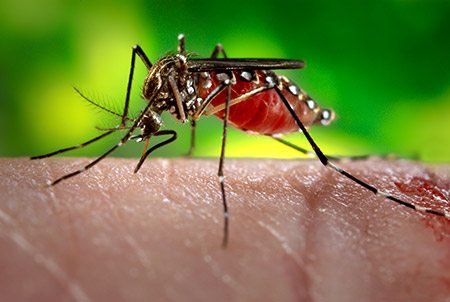Posted by Steven Novella on February 10, 2016 A new word has been added to the public’s vocabulary – the Zika virus. It seems we have one more infectious agent to worry about. Here are the facts as we currently understand them regarding the recent Zika epidemic, and also some rumors and conspiracy theories that need debunking. Zika virus The Zika virus (of the viral family Flaviviridae, an Arthropod-Borne or arbovirus) is spread through Aedes mosquito bites, the same mosquitoes that also spread dengue fever, West Nile, and yellow fever. The infections themselves are usually mild, causing fever, rash, joint…
 A new word has been added to the public’s vocabulary – the Zika virus. It seems we have one more infectious agent to worry about. Here are the facts as we currently understand them regarding the recent Zika epidemic, and also some rumors and conspiracy theories that need debunking.
A new word has been added to the public’s vocabulary – the Zika virus. It seems we have one more infectious agent to worry about. Here are the facts as we currently understand them regarding the recent Zika epidemic, and also some rumors and conspiracy theories that need debunking.
Zika virus
The Zika virus (of the viral family Flaviviridae, an Arthropod-Borne or arbovirus) is spread through Aedes mosquito bites, the same mosquitoes that also spread dengue fever, West Nile, and yellow fever. The infections themselves are usually mild, causing fever, rash, joint pain, and conjunctivitis. Many of those infected (about 80%) may even have a subclinical infection, meaning they do not notice any symptoms.
According to the World Health Organization:
Zika virus is diagnosed through PCR (polymerase chain reaction) and virus isolation from blood samples. Diagnosis by serology can be difficult as the virus can cross-react with other flaviviruses such as dengue, West Nile and yellow fever.
Although the primary infection is mild, the infection can have complications. There is one case report of Guillain-Barre Syndrome (GBS) following a Zika infection. GBS causes inflammation of the lining of nerves resulting primarily in weakness with variable recovery. This does not appear to be a huge risk, but something to monitor.
The bigger concern is if a pregnant women becomes infected. There are numerous reports of poor pregnancy outcomes, mostly microcephaly, in women who have been infected with Zika while pregnant. Microcephaly means small head, and results from poor brain development (more on this below).
There is currently no treatment for a Zika infection (other than usual supportive care if necessary). There is also no vaccine, although efforts are already underway to develop one.
Zika was first identified in Uganda in 1947. It spread throughout Africa, and then spread to Southeast Asia in the late 20th century. Recently it has also spread to South America and Mexico, with Brazil being a particular hot spot.
There are as yet no cases of locally acquired Zika in the US. There have been a few cases of people returning from travel to South America with a Zika infection. It is possible for Zika to become endemic in the US.
The virus can spread wherever there are Aedes mosquitoes, which exist throughout the Americas except for Peru and Canada. Interestingly, these mosquitoes were previously localized to the tropics and subtropics, but have been spread as invasive species by human activity – paving the way for later viral infections.
Zika is in the news now because its pace of spread has dramatically increased. It is no longer a “slow” pandemic, but rather is spreading rapidly.
Microcephaly
The Zika infection itself is mild, in fact it is less of a problem than the flu. However, what has caused such great concern is the apparent association between Zika outbreaks and a condition known as microcephaly.
At this point the connection is still a correlation without proven causation, but the Zika virus being the cause is likely and it is reasonable to assume this is the case unless evidence proves otherwise.
Brazil is the center of the microcephaly concerns. According to reports, drawing from a CDC study published in January:
Public health officials in Brazil are investigating more than 4,000 cases of suspected microcephaly, and have confirmed more than 400. Prior to the Zika outbreak, Brazil saw on average 163 cases annually of microcephaly over the past five years, according to WHO. In 17 of the new cases, the presence of Zika was identified in the mother or the baby.
A study of 35 Brazilian babies born with microcephaly during the Zika outbreak reported by the CDC Jan. 29 added strength to the suspected connection.
The mothers of all 35 infants had lived in or visited Zika virus-affected areas during pregnancy, the report said. Twenty-five infants had severe microcephaly, and 17 had at least one neurologic abnormality.
In addition to the spike in cases of microcephaly in areas of Zika infection, the cases themselves are unusually severe. Microcephaly experts have examined the brain scans of some of the cases, and found:
“These children have a very severe form of microcephaly,” Dobyns said. “The brain is not just small, it’s small with malformations of the cerebral cortex and calcifications. It has the appearance of a very severe, destructive injury to the brain.”
There is also evidence that the brains in severe cases have actually shrunk. These findings all point to severe brain injury as a result of the infection. These children are going to have severe lifelong neurological impairment.
While the connection between Zika and the spike in microcephaly needs to be absolutely confirmed, the evidence so far is very compelling, and other likely causes so far have been ruled out.
What to do?
As there is no treatment or vaccine for Zika, basic precautions are necessary. This mostly involves limiting mosquito populations and avoiding exposure. Mosquitoes breed in standing water, even small puddles or containers with water. Eliminating any standing water is therefore an important measure.
Ponds and lakes can also be sprayed. In the US, the CDC embarked on a campaign to eliminate malaria in the South through control of mosquito populations, and they were successful. So it is possible to reduce mosquito populations to such a degree that infections cannot spread – although malaria is not a virus, which may be more difficult to control.
Meanwhile, those living in areas with the mosquitoes can use repellent, keep their windows closed, use mosquito nets, and take other measures to avoid being bitten.
The WHO and CDC are advising pregnant women not to travel to areas where there is currently an outbreak of the Zika virus. They are also suggesting that women who live in an area of an active outbreak might want to delay pregnancy, although they acknowledge this is a very personal decision.
Conspiracies
Of course, no news story is wasted by the conspiracy theorists. There are already a number of rumors and conspiracies about the Zika virus, all apparently made up out of whole cloth.
Some anti-vaccine and medical conspiracy sites are blaming vaccines for the cases of microcephaly, specifically the Tdap vaccine given to pregnant women. There is no evidence for these claims.
In fact, there have been a number of safety studies showing no increased risk of adverse events in children of women receiving the Tdap vaccine during pregnancy.
Another popular conspiracy theory is that the virus is being spread by genetically modified mosquitoes. This theory fails on multiple levels, but perhaps the single biggest failure is that the genetically modified mosquitoes are all male, and male mosquitoes do not bite. The males are nectar feeders, and only the females feed on blood.
There are also a number of conspiracy theories that the outbreak of Zika is a hoax, or was created on purpose for some nefarious reason. These are Illuminati-level grand conspiracies and are not even coherent enough to directly address.
The big picture
The public has had to deal with a series of new serious infections emerging in the world. Prior to 1980 no one had ever heard of HIV. This infection emerged as a world-wide pandemic fairly quickly, and literally changed the practice of medicine. Now we take for granted that we live in a world with HIV.
More recently the H1N1 flu emerged as a new strain, although fortunately did not turn out to be as virulent as feared. Still, we had to adapt, and now the annual flu vaccine targets the H1N1 strain routinely, in addition to the predicted circulating strains.
We have been hearing about the avian influenza (bird flu) for a number of years. This is an extremely virulent form of the flu that primarily affects birds and is a threat to the poultry industry. There are individual cases of humans being infected, but currently this virus is not spread from person to person. The fear is, however, that one or more strains will make the full transition to the human population and we could see a serious pandemic.
There have been serious pandemics in the past. Perhaps the most famous was the flu pandemic of 1918, which killed between 20-40 million people (more than World War I).
Fortunately the WHO and CDC are doing their job. They are on top of such outbreaks – that’s why we hear about them. The CDC is confident that if Zika reaches the US directly (so far it is just isolated cases of people coming from Zika areas), that they can contain the spread.
Outbreaks, epidemics, and pandemics are just part of the reality of having a large world-wide population. The Zika virus is just the latest example, and there are certain to be others. It is not fearmongering (as some conspiracy theorists suggest) to warn about emerging infections and to encourage people to take basic precautions.
Because the Zika virus is spread by mosquito, we can significantly reduce its spread by reducing mosquito populations and protecting against being bitten by mosquitoes. Meanwhile scientists are working on a vaccine.
Our greatest defense against the persistent reality of infectious diseases is science and information. Our greatest threat, more than the virus itself, is ignorance and misinformation.
Source: Update on the Zika Virus : Science Based Medicine





